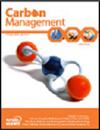国内经济周期背景下内含碳转移网络的时空演变
IF 3.2
4区 环境科学与生态学
Q3 ENVIRONMENTAL SCIENCES
引用次数: 0
摘要
本文章由计算机程序翻译,如有差异,请以英文原文为准。
Temporal and spatial evolution of embodied carbon transfer network in the context of the domestic economic cycle
Abstract Under accelerated domestic economic cycle, it is significant to predict the embodied carbon transfer network (ECTNs) to identify key emission regions to improve emission reduction efficiency. Based on the existing China Multi-regional Input-Output Table (CMRIOs) for 2002, 2007, 2010, 2012, 2015 and 2017, the CMRIOs for 2002-2017 were updated, then the ECTNs were predicted and constructed from 2018 to 2025 through Particle Swarm Optimization- Support Vector Model. Finally, the spatial and temporal evolution trends of the ECTNs’ features were explored through complex networks analysis. The results showed that carbon leakage between provinces has been becoming increasingly serious. The small-world features of the ECTNs were becoming increasingly obvious. The distribution of provinces with great influence on carbon transfer was transferred from north to south, and then to the central region. Hebei, Jiangsu, Henan, Zhejiang, Inner Mongolia, and other resource-intensive and manufacturing provinces played an important "bridge" role in the trade between economic developed and developing provinces. Trade ties between non neighboring provinces have become increasingly close, which means the development of China’s integration has strengthened. This study provides a theoretical reference for the formulation of China’s overall carbon emission reduction policy. Graphical Abstract
求助全文
通过发布文献求助,成功后即可免费获取论文全文。
去求助
来源期刊

Carbon Management
ENVIRONMENTAL SCIENCES-
CiteScore
5.80
自引率
3.20%
发文量
35
期刊介绍:
Carbon Management is a scholarly peer-reviewed forum for insights from the diverse array of disciplines that enhance our understanding of carbon dioxide and other GHG interactions – from biology, ecology, chemistry and engineering to law, policy, economics and sociology.
The core aim of Carbon Management is it to examine the options and mechanisms for mitigating the causes and impacts of climate change, which includes mechanisms for reducing emissions and enhancing the removal of GHGs from the atmosphere, as well as metrics used to measure performance of options and mechanisms resulting from international treaties, domestic policies, local regulations, environmental markets, technologies, industrial efforts and consumer choices.
One key aim of the journal is to catalyse intellectual debate in an inclusive and scientific manner on the practical work of policy implementation related to the long-term effort of managing our global GHG emissions and impacts. Decisions made in the near future will have profound impacts on the global climate and biosphere. Carbon Management delivers research findings in an accessible format to inform decisions in the fields of research, education, management and environmental policy.
 求助内容:
求助内容: 应助结果提醒方式:
应助结果提醒方式:


